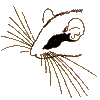

Dormouse Talk Instructions and Archives
How to Subscribe
Compliled and Edited by Werner
Haberl
Number of recipients: > 105
Please share your thoughts and answers with the rest of the group!
Replies to the following messages should be sent as CC-Mail to dormouse@glirarium.org
Dear Werner
Thank you very much for your work in building up the dormose web site and the newsletter. I send you a list of my papers on garden dormouse and a reply to the question posed by Maurizio Sarà'.
Reply to Maurizio Sarà'
To catch garden dormouse we use Sherman live-traps, placed at 20 m intervals, in a regular grid. Traps, usually 100-140, are placed on the ground, baited with hazelnuts, cheese, and carrots. In our first study area, a trapping session of 5-6 days was enough to catch all the animals in the trapping grid, but in our new area we had more problems. Animals are trapped once a month, from May till September. This is for intensive field study; for a preliminary record of the species, 50 traps set up for 3-4 days are enough to confirm the presence of the garden dormouse. In my experience here in the Alps, the garden dormose is usually easy to catch on the ground if there is a good stones/rocky cover, but animals usually avoid woodlands with wide grass cover and few stones. Probably, the possibility to move through the home range using ground cover, hole and others refuge is an important factor, as in other small mammals, for avoid avian predators
About marking, we used Passive Integrated Transponders for some years, but now we are testing the ear-tattooing method, has used with muscardinus by many researchers, and seems to work very good.
Best regards
Sandro Bertolino
DI.VA.P.R.A. Entomology & Zoology
Via L. da Vinci, 44
10095 Grugliasco (TO), Italy
Tel. +39 0116708535
Fax +39 0116708586
Glis is known to be very vocal, but to my knowledge, the significance of this behaviour is unknown. Miroslaw Jurczyszyn, Dept. of Syst, Zool., Adam Mieckiewicz University, Fredry 10, 61-701 Poznan, Polan, had interest in this; possibly, he will be able to tell you more.
Ingo Rieger's observations are very interesting. I agree that vocalisation in Glis is not connected with sexual activity - I found animals with wounds in the skin (ie from antagonistic behaviour), immediately after the emergence of females (beginning of July), but the highest vocal activity is in August!
I don't believe that dormice are "safe" in the canopy - owls are important predators, at least in some areas of Europe. Many of Ingo's suggestions are worth of further research,
Boris Kryštufek
Slovenian Museum of Natural History
Hi Costas,
I monitored such changes from emergence in May-June until the middle of September. This was submitted for publication in the proceedings of the Edirne dormouse meeting. However, the most important things are happening in the 2nd half of Sept. and in Oct.; I have a lot of material from last autumn, but it has not been elaborated yet. However, I believe that things in "bella Grecia" might be different, considering Slovenia's severe winters. Our dormice are also much bigger than yours.
Boris Kryštufek
Slovenian Museum of Natural History
Lieber Herr Haberl,
Danke fuer die Shrew-Site. Ich habe auch auf die Gliriden-Seite gesehen, wenn Sie Literatur zum Zahnschmelz aufnehemen wollen, sind hier drei Zitate.
KOENIGSWALD, W.v. (1993): Die Schmelzmuster in den Schneidezähnen der Gliroidea (Gliridae und Seleviniidae, Rodentia, Mammalia) und ihre systematische Bedeutung. - Z. Säugetierkd. 58: 92-115; Hamburg.
KOENIGSWALD, W.v. (1994) Der Zahnschmelz von Bransatoglis. - 24 in Fejfar O. & Storch, G.: Das Nagetier von Valec-Waltsch in Böhmen -ein historisches fossiler Säugetierfund - (Rodentia: Myoxidae). -Münchner Geowiss. Abh. 26; München.
KOENISGWALD, W.v. (1995): Enamel differentiations in myoxid incisors and their systematic significance. - Hystrix, n.s. 6/1-2: 99-107, 5 fig.; Rom.
Ich habe gerade alle mir fassbaren fossilen und rezenten Nager nach einem sehr eingenwillgen und hoch abgeleiteten Merkmal im Schmelzmuster durchgesehen. Es tritt bei den Gliroidea ebenso wie bei den Muriodea, Dipodidea, Geomyoidea und Eomyiden auf, aber bei keiner Nagetiergruppe ausserhalb. Das bestätigt die Einheit der Myomorpha im Sinne von WOOD 1985. - Aber wen interssiert das? (Ist auch noch nicht gedruckt).
Ihr W.v.K.
Prof. Dr. Wighart v. Koenigswald
Institut fuer Palaeontologie der Universitaet Bonn
Nussallee 8, D-53115 Bonn
Tel. xx49 (0)228 733104
FAX xx49 (0)228 733509
www.uni-bonn.de/Paleontology
Bertolino S., Currado I., 1997. Passive Integrated Transponders for marking Garden dormuose Eliomys quercinus. Nat. Croat., 6 (2): 243-251.
Bertolino S., Currado I., Azzollini R., Viano C., 1997. Social organization, home range and movement of the Garden dormouse Eliomys quercinus. Nat. Croat., 6 (3): 303-312.
Bertolino S., Viano C., Currado I., (accepted). Population dynamics, breeding patterns and spatial utilisation of the garden dormouse Eliomys quercinus in an Alpine habitat. Journal of Zoology, London.
Sandro Bertolino
DI.VA.P.R.A. Entomology & Zoology
Via L. da Vinci, 44
10095 Grugliasco (TO), Italy
Tel. +39 0116708535
Fax +39 0116708586
We found two dormice, age nearly two weeks; who can help us by showing some links to pull them through the next weeks?
Mike Riedner
Hirschberg, Germany
www.glirarium.org/dormouse/
Number of Visitors (Date: 16. August 2000): >1127
Number of recipients: >105
Dormouse Talk Instructions: ... how to join, post & leave
Dr. Werner Haberl
Editor of DORMOUSE TALK & SHREW TALK
Chair, Insectivore Specialist Group
Species Survival Commission
IUCN - The World Conservation Union
Hamburgerstr. 11, A-1050 Vienna, Austria
Email: dormouse@glirarium.org
The Dormouse Hollow: www.glirarium.org/dormouse
The Shrew Shrine: members.vienna.at/shrew
IUCN / ITSES: members.vienna.at/shrew/itses.html
Back to Dormouse Talk Archives / Index